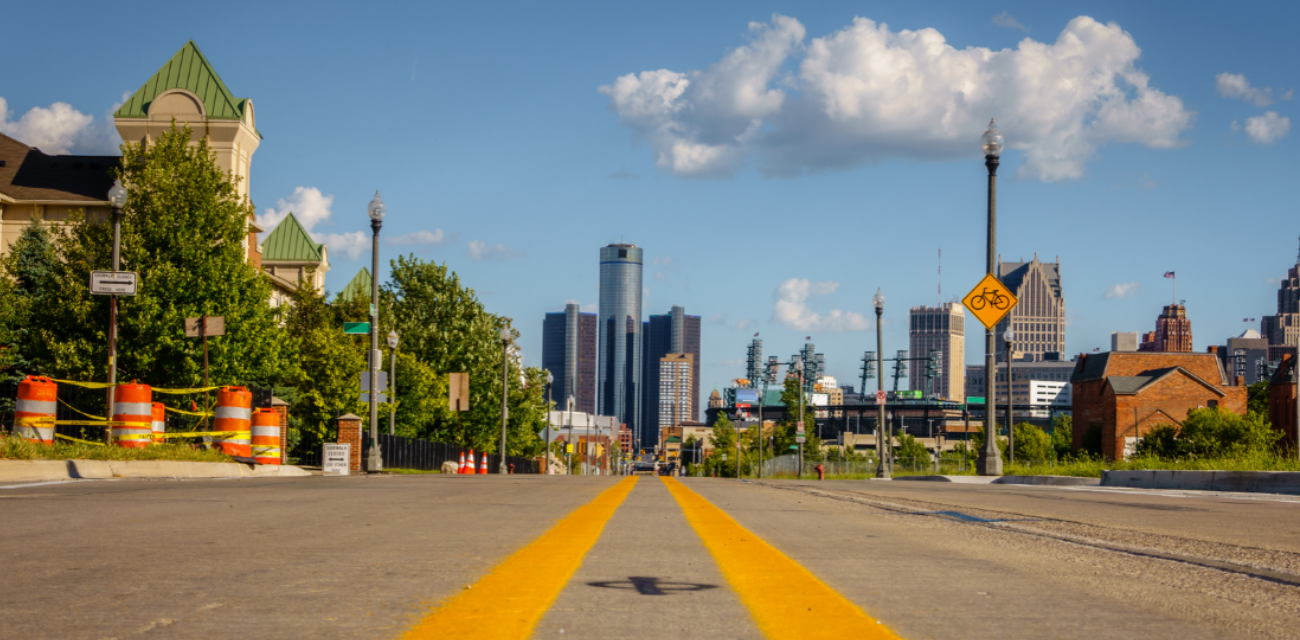Matt Cullen: 2017 Milliken Award winner

The downtown Detroit of today stands in stark contrast to the Detroit of ten years ago; a new energy pulses through the city’s core, a feeling of possibility and hope for a better future. New residents and businesses are moving into formerly blighted buildings. The abandoned industrial sites along the riverfront are being replaced with parks and bicycle paths. A new streetcar is inspiring residents to rethink mobility in the Motor City.
Through all this change one name has remained constant — Matt Cullen, a Detroit native who has used his professional expertise in economic development to make his hometown a stronger, more connected community through sustainable development.
“When people talk about downtown Detroit’s resurgence, Matt Cullen’s name is the common thread,” said Chris Kolb, Michigan Environmental Council president. “He has led many of the initiatives that are revitalizing downtown Detroit and he’s doing it in a way that promotes sustainability and shifts the city away from its legacy of sprawl and auto dependence.”
Cullen works as a principal at Rock Ventures, CEO of Jack Entertainment, and the voluntary CEO of the QLINE. As if he wasn’t busy enough, Cullen also serves on the board of numerous local nonprofits. His many hats have availed him the opportunity to steer projects that have revitalized the city’s core.
His business motto is, “to do good and to do well,” and his commitment to Detroit’s recovery has been unshakable. Due to Cullen’s efforts, Detroit is repositioning itself as a city where sustainability is a cornerstone of success. In recognition of his role in making the Motor City a better place to live, work and play, Cullen joins other community champions as the recipient of the Michigan Environmental Council’s Helen and William Milliken Distinguished Service Award.
Connectivity: the secret sauce
For nearly 30 years, Cullen worked as an economic development executive at General Motors. GM gave him the opportunity to travel the world and learn what made cities grow and thrive. After each trip, Cullen would return home to Detroit and wonder what it would take to make his hometown a world class city once again.
Cullen realized that the difference between the world’s great cities and Detroit was rooted in urban planning. Detroit lacked connectivity, which is what Cullen considers the “secret sauce” to the city’s revitalization. As Cullen saw it, “We needed to create space where people can interact with each other, but connectivity is also about how we physically move people around.”
Detroit’s reputation as the Motor City shaped its design. The region’s vast highways, boulevards, and parking lots served to divide and isolate residents; its auto-centric infrastructure set the stage for low-density, suburban sprawl which has contributed to air pollution and climate change, and exacerbated the city’s economic challenges as residents moved to the suburbs — taking their tax dollars with them.
Connectivity guides Cullen’s strategy for downtown Detroit’s recovery. Through his many projects he has sought to encourage mass transit and non-motorized options. He believes that with greater connectivity, with an eye towards environmental sustainability, we can create a vibrant downtown core where people — especially the young — want to live.
Reimagining downtown Detroit
For over ten years, Cullen served as the chairman of the Michigan Economic Development Corporation (MEDC). The group was tasked with understanding Michigan’s economic challenges and identifying solutions. MEDC quickly concluded that the region and state couldn’t be successful without Detroit, and so the question became: After decades of economic decline, what does Detroit need?
While there is no single solution, Cullen and his team identified one cause of the city’s economic distress that they felt they could help — population loss. In Cullen’s opinion, Michigan was exporting one of its most valuable resources– bright, young college graduates. “It was painfully apparent that we had this great university system in Michigan, but new graduates didn’t want to move into the suburbs,” he says. “They wanted an urban experience.”
Cullen’s drive to retain young people also had its personal motivations. “I’m a hometown guy,” he says, “and on an emotional level, unless we’re prepared to travel out of state to see our kids and grandkids, we needed to change the city’s calculus.”
For Cullen, the urban wants of the educated, tech-savvy millennials didn’t stray far from the needs of the city’s longtime residents. Detroit had long struggled with transportation inequities; one out of four residents don’t have a car and struggle to reach jobs in the suburbs. If native Detroiters were going to be part of the city’s resurgence they needed mass transit too.
While the case for connectivity was evident, Cullen’s challenge laid in developing a viable plan to remake downtown into a connected, sustainable and attractive city core. Through his dedication and hard work, coupled with his unshakable notion that urban reinvention was possible, Cullen was able to lead the way through some of the city’s darkest days.
From industrial wasteland to recreational destination
When asked about his favorite project, Cullen immediately answers: “Detroit’s riverfront!”
For many of us, water is central to what it means to be a Michigander, but for decades Detroit’s residents couldn’t enjoy the city’s riverfront.
During his tenure at General Motors, Cullen was instrumental in the company’s purchase of the Renaissance Center, but for Cullen it wasn’t enough to bring GM’s headquarters home. With an eye towards urban design, he saw distinct flaws with the RenCen site — berms blocked the building from the rest of the city and multilane roads made it impossible to walk from the RenCen to the riverfront. “I think back to 1996 when we bought the property,” Cullen says, “There wasn’t any place where people could come together and interact with one another. We set out to do that.”
In 2003, Cullen became the founding chairman of the Detroit RiverFront Conservancy where he shepherded the billion dollar redevelopment of the waterfront. The riverfront is now a 3.5-mile thriving ribbon of parks, plazas, pavilions, and greenways that stretches from downtown to Belle Isle and attracts over 3 million visitors annually.
Before the riverfront’s makeover, the area was a largely abandoned industrial district. Easy access to the Detroit River was key to the city’s ascension as a manufacturing powerhouse, but as the economic tides turned, Detroit inherited polluted industrial sites and overgrown lots. Cullen knew the area had to be redeveloped for downtown to thrive so he rallied his colleagues. “We came together and said: this is not okay,” Cullen explains. “We didn’t want to have that type of abandon on our waterfront. We wanted to create value, so we brought folks together to get it cleaned up.”
When it comes to the riverfront’s redevelopment, Cullen isn’t slowing down. “In the next five years we want to double the impact we have made in the last 15 years,” he says.
Connectivity remains the primary goal. The conservancy plans to build two new greenways to connect downtown with neighborhoods north of Jefferson Avenue, similar to the Dequindre Cut which has connected the riverfront to Eastern Market. Cullen is also excited to build Atwater Beach, which will fill a gap in the riverfront between Chene Park and Stroh River Place.
While the revived riverfront is beginning to connect downtown with nearby neighborhoods, many Detroiters still have a difficult time accessing the riverfront and the opportunities downtown — that’s where Cullen’s vision for mass transportation comes in.
From Motor to Mobility City
A comprehensive mass transit system is a crucial part of the path to better opportunities for Detroit and its residents. As Cullen explains, “Young tech talent wants transit, but it’s also about the folks who have lived here a long time, who don’t have access to a car and need this connectivity to access opportunities.”
In 2015 Detroit Free Press ran a story about James Robertson, a Detroiter who walks 21 miles a day to get to his job outside the city. Unfortunately, Robertson’s story is not unique. The majority of Detroit’s residents work outside city limits and struggle to reach jobs in the suburbs by bus. Detroit’s lowest wage workers tend to have the longest commutes; 36% travel to jobs that pay less than $15,000 per year.
Cullen’s ultimate vision for connectivity includes a comprehensive, regional mass transit system that will serve Detroit and the surrounding suburbs. But after many false-starts promoting mass transit, Cullen picked a single project to push forward – the QLINE – which he hopes will inspire the region to reimagine how the Motor City moves.
In 2007, a nonprofit was formed and tasked with designing, building and operating the QLINE. Cullen took the helm as their voluntary CEO because he felt that “transit was critical for the community. People had been talking about transit for fifty years since the streetcars were taken out,” he said. “We need transit; we need a regional approach to it.”
After a decade of coordination between public agencies and private entities, the 6.6-mile QLINE opened in May 2017. The route includes twelve stops at destinations including Comerica Park, Wayne State University, and other destinations that collectively employ 30,000 people. The street car has also spurred $7 billion in economic development along the Woodward corridor and Cullen hopes that more development comes. “It’s an ongoing discussion to convince people that economic opportunities, connectivity, and sustainability are not mutually exclusive,” Cullen explains. “They are interdependent.”
In a nod to the past, Cullen’s long-term goal is to expand the QLINE north into Pontiac and expand service throughout downtown, where density warrants it. Cullen’s aspirations for greater connectivity also include rapid bus transit and a connection to the metro airport. When asked how we can accomplish comprehensive, regional mass transit he says, “Get the Regional Transit Authority funded and in place next year. That will be key.”
The Spirit of Detroit
In true Detroiter spirit, Cullen never gave up on his hometown. When asked about his unshakable resolve to reinvent the city, he says “when it’s your hometown, it makes everything more personal. You remember the city it was, and you aspire to have it become a world class city again. Increasingly, that means that the environment and sustainability must be a part of the planning process.”
When you consider Detroit’s car-centric culture, coupled with the economic downturn, political turmoil, and the bankruptcies of Detroit’s top industries and its city government, Cullen’s work becomes all the more impressive — a testament to how the tenacity, hard work, and commitment that has long defined Detroit can also help guide it towards sustainable revitalization.
Discover
Power environmental change today.
Your gift to the Michigan Environmental Council is a powerful investment in the air we breathe, our water and the places we love.
Sign up for environmental news & stories.
"*" indicates required fields




